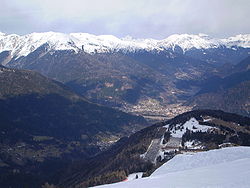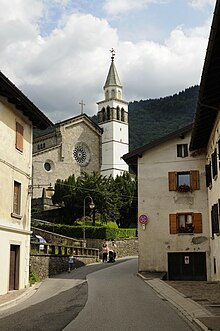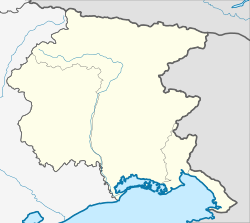Paluzza
Paluce (Friulian) | |
|---|---|
| Comune di Paluzza | |
 View from Monte Zoncolan | |
| Coordinates: 46°32′N 13°1′E / 46.533°N 13.017°E | |
| Country | Italy |
| Region | Friuli-Venezia Giulia |
| Province | Udine (UD) |
| Frazioni | Casteons, Cleulis, Naunina, Rivo, Timau |
| Government | |
| • Mayor | Massimo Mentil |
| Area | |
| • Total | 69.75 km2 (26.93 sq mi) |
| Population | |
| • Total | 2,158 |
| • Density | 31/km2 (80/sq mi) |
| Demonym | Paluzzani |
| Time zone | UTC+1 (CET) |
| • Summer (DST) | UTC+2 (CEST) |
| Postal code | 33026 |
| Dialing code | 0433 |
| Website | Official website |

Paluzza (Friulian: Paluce) is a comune (municipality) in the Regional decentralization entity of Udine in the Italian region of Friuli-Venezia Giulia.
Geography
[edit]It is located about 120 kilometres (75 mi) northwest of Trieste and about 50 kilometres (31 mi) northwest of Udine, in the historic Carnia region of Friuli, close to the border with Austria at Plöcken Pass (Italian: Passo di Monte Croce Carnico).
Paluzza borders the following municipalities: Arta Terme, Cercivento, Comeglians, Forni Avoltri, Kötschach-Mauthen (Austria), Lesachtal (Austria), Paularo, Ravascletto, Rigolato, Sutrio, Treppo Ligosullo.
The municipal area comprises the frazioni of Casteons, Cleulis, Englaro, Naunina, Rivo, and Timau (German: Tischelwang), where a particular variant of the Southern Bavarian dialect is spoken. A local term in the Bavarian language for "hello" is pfiati.
Sights include the Torre Moscarda, a surviving structure of a castle (Castrum Moscardum) built here by the Patriarch of Aquileia Gregorio di Montelongo; nearby are remains of ancient Roman and World War I fortifications.
References
[edit]- ^ "Superficie di Comuni Province e Regioni italiane al 9 ottobre 2011". Italian National Institute of Statistics. Retrieved 16 March 2019.
- ^ All demographics and other statistics: Italian statistical institute Istat.
- ^ "Popolazione Residente al 1° Gennaio 2018". Italian National Institute of Statistics. Retrieved 16 March 2019.





Well, that’s interesting to know that Psilotum nudum are known as whisk ferns. Psilotum nudum is the commoner species of the two. While the P. flaccidum is a rare species and is found in the tropical islands. Both the species are usually epiphytic in habit and grow upon tree ferns. These species may also be terrestrial and grow in humus or in the crevices of the rocks.
View the detailed Guide of Psilotum nudum: Detailed Study Of Psilotum Nudum (Whisk Fern), Classification, Anatomy, Reproduction